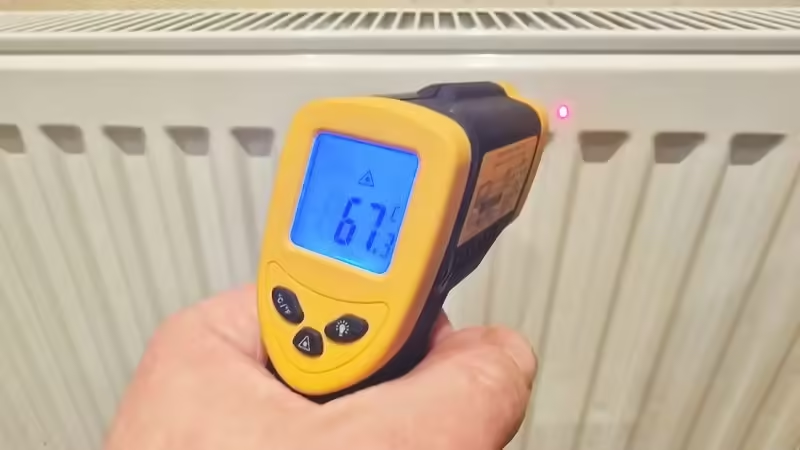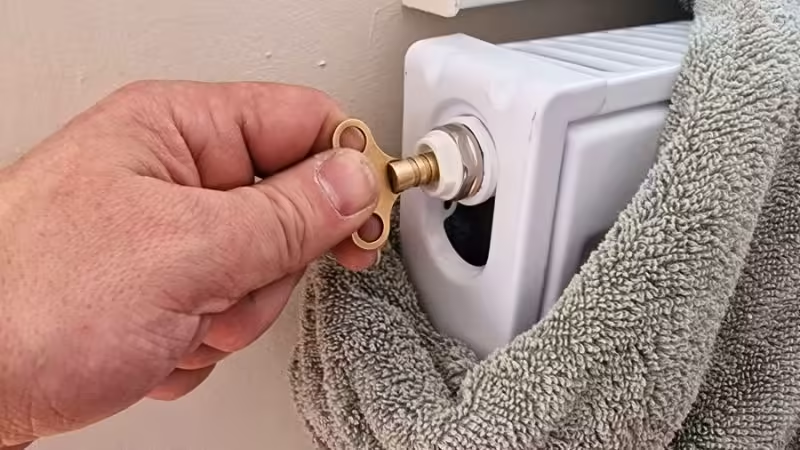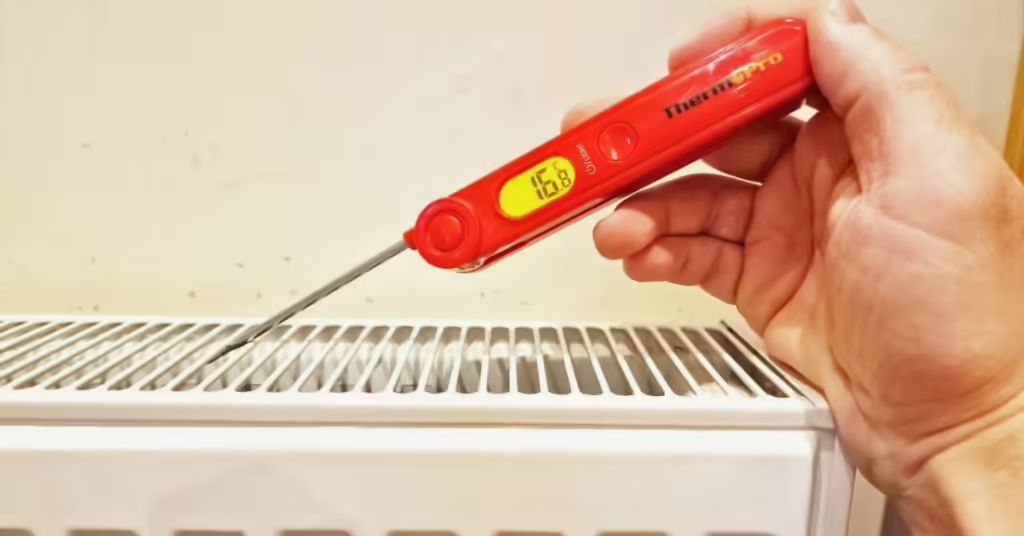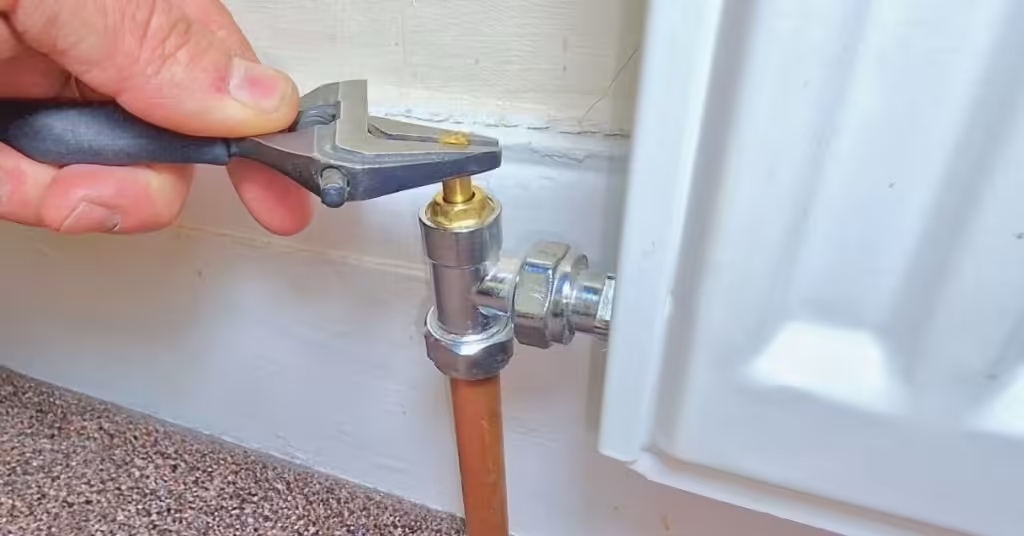Last updated on October 9th, 2024
Are some of your radiators not heating up properly, even after bleeding them? Balancing your radiators can be time-consuming, but the payoff is worth it. The aim is to ensure all your radiators heat evenly.
With over a decade of experience as a full-time heating engineer balancing and repairing radiators, I understand it’s not always the most enjoyable task but it’s essential for a well-functioning system.
Balancing Radiators
Most central heating systems run efficiently without needing balanced, but in some cases, it’s necessary. To balance your radiators, you’ll need to partially close the lockshield valves on the hottest radiators, allowing heat to distribute evenly to the colder ones.
All you need is an adjustable spanner (or water pump pliers) and a laser thermometer. Alternatively, a thermal imaging camera works well too.

Make sure radiators need balancing
You should confirm the radiators need to be balanced before wasting time balancing.
A radiator not getting hot can be caused by many reasons, here are some:
- The radiator needs bleeding
- The radiator or system is dirty and needs to be flushed
- A radiator valve is turned off, blocked, or faulty
- The radiator is not piped up correctly (if it has got hot before then this isn’t the problem)
- The central heating pump is faulty or undersized
Bleed the radiators
There is no point trying to balance radiators until you have tried to bleed the radiators first. Bleeding the radiators should be the first thing to try when you have radiators that are not getting hot.

This is the simplest solution to try first. Use a bleed key to open the bleed valve on each radiator until water starts coming out.
Remove the radiator?
A radiator that doesn’t get hot at the bottom is a sign that there is sludge in the radiator so balancing it will not help. If this is the case you can remove the radiator and get a hose on it outside to clear the sludge out or if it’s old and rusting you might be better off replacing the radiator.
If you are still having problems with some radiators not getting hot or as hot to touch as others, then balancing them is the next step to heating your home properly.
How to turn off a radiator valve
To turn off a radiator valve for balancing, you must close the lockshield valve on the hot radiators. If you have thermostatic radiator valves (TRVs) on any of your radiators, these need to be fully open on max setting at all times while balancing the system.
If you do not turn on the thermostatic valves, the radiators will turn off when they have reached the temperature set on the TRV and mess things up.
To turn off lockshield valves, you must turn the top of the valve clockwise as far as it will turn. If it has a handle, you can use your hand. If not, you must use an adjustable spanner or water pump pliers. After you have closed the valve, if it still gets hot then you need to replace the radiator valve as it’s faulty.
How to Balance Radiators
To balance a central heating system, you must spread the heated water evenly around your radiators. You do this by restricting the water from going to the hotter radiators and forcing it to go to the colder radiators by closing one lockshield valve on each radiator.
You must open all thermostatic radiator valves fully on the highest setting when balancing radiators
My step-by-step process for balancing radiators:
- Turn the heating on
- Close one lockshield valve on all the hot radiators
- Make sure the valves on the cold radiators are fully open
- The cold radiators should now get hot, and the normally hot radiators shouldn’t have any heat at all
- If the problematic radiators are still not hot, then balancing your radiators is probably not the solution to your problem
- Open all the closed lockshields a quarter turn with an adjustable spanner or another tool
- Leave it for half an hour or so to let the system heat up
- Go around with your thermometer and check the temperature of all the radiators and make notes of what they are
- Then go around tweaking each radiator via the lockshield. If a radiator is not as hot as the others, then open the lockshield a little more. If any of them get hotter than the fully open radiators, then close them a little
Some lockshield valves are sensitive to the smallest of turns, so you might go back and forth a few times from too hot to too cold with certain radiators before you get it right. It can be very time-consuming and frustrating.
When you tweak a radiator you need to leave it a while to reach the new temperature, so keep going around all the radiators checking and tweaking. They don’t have to be the exact same temperatures, but you want them as close as possible.
When you have got them as close to the same temperatures as possible, turn the heating off and let it cool down fully and then turn the heating back on and check temperatures again, then get tweaking again if needed.
Balancing Radiators Without a Thermometer
You can balance your radiators without a thermometer by simply using your hands to gauge the temperature. Although this method isn’t very precise, it can still work. I relied on this approach for several years before investing in a laser thermometer.
If your radiators need balancing, you’ll likely notice significant differences between the temperatures of the cooler radiators and the hotter ones. So even without a thermometer, you can still achieve good results.
Just follow the step-by-step radiator balancing process, and use your hands to feel the radiator temperatures instead of relying on a thermometer. Ideally, each radiator should be too hot to comfortably touch for more than a few seconds.
Unbalanced Radiators Symptoms
Unbalanced radiator symptoms are cold radiators or radiators that are not hot enough to heat the room properly. Which means cold rooms. Most central heating systems I work on have unbalanced radiators. If you have cold radiators, this does not mean they are cold because they are unbalanced, it could mean you need to bleed your radiators or flush the central heating system.
Summary
Balancing radiators is a skill well worth knowing. It can seem very complicated at first but it’s simple really, just very time-consuming sometimes.
Some radiator valves can be sensitive and the slightest turn can make the radiator turn off or on. Finding the right balance is key and you must keep tweaking it until you get it right.
If you are balancing radiators in your own home then you can't really fail to get it right eventually as you can keep tweaking the valve whenever you like.
Feel free to ask any questions in the comments below, and I’ll do my best to help. If you found this post helpful, please consider sharing it.
FAQs
When would you balance a central heating system?
You would balance a central heating system when you’re having problems with certain radiators not getting hot. If you have one or two radiators that don’t get as hot as the others, you will most likely need to balance your radiators.
What side of the radiator is the lockshield valve?
The lockshield valve is not fitted to any particular side of the radiator. A thermostatic radiator valve is fitted to whatever side is most appropriate for the room that the radiator is in, and the lockshield valve is fitted on the other side. Sometimes times there is a lockshield valve on both sides of the radiator.






1. I’ve seen other posts that mention determining which is the inlet and which is the out let and that you should always restrict the outlet for balancing purposes as it means the full pressure is on the full radiator and only restricted at the out let valve. You don’t mention this at all, do you not agree with this sentiment ?
2. Would it not be better to open every valve fully and the start to close off the hottest until everything is balanced rather than opening the coldest to get more heat?
1. you could only do that on radiators without thermostatic valves but I don’t see it changing anything in any way.
2. the coldest should be fully open anyway, if they’re not that might be why it’s not getting enough heat.
I have a large house with numerous radiators of differing sizes and styles. I have (as much as is possible) worked out the order of the radiators heating and have systematically gone around the house getting the incoming/outgoing heat to approx 12deg between each. The only issue is that as I get closer to my ‘cold’ radiator (the cause of all this hard work) I am getting no heat coming to it at all, nor the pipes, but I can feel warmth in the wall with the pipe. Each radiator is still turned up to full. Is it possible to turn down the other rads to see if system capacity is an issue? If not, I’m guessing some crud must have got into this last radiator, even though it is new! Grateful for any help!
Hi Pippa,
You should turn off all the hot radiators and see if the cold radiator gets hot. You just need to close one valve on each radiator.
If the cold radiator doesn’t get hot then balancing the system won’t help. A radiator valve could be blocked or broken.
You might find this post helpful https://housewarm.co.uk/radiator-not-heating-up/
Hi – I have 6 radiators in my flat, 2 get really hot while the other 4 are cold. Bleeding didn’t help so going to try to rebalance them. The radiators have a Drayton RT212 valve and a lockshield valve, apart from the large radiator in my living room, which has two lockshield valves on each side and no TRV (probably because this radiator is close to the central heating control). The living room radiator is one of the 2 radiators that gets really hot, so I would need to close the lockshield valve on it to force the others to warm up as per your balancing instructions. My question is, do I close one or both of the lockshield valves on the big living room radiator?
Hi Anita, you only need to close one lockshield valve when balancing radiators. Good luck!